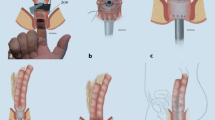PURPOSE: Disconnection of an ileal pouch-anal anastomosis with repeat ileal pouch-anal anastomosis has been proposed for treatment of ileal pouch-anal anastomosis failure caused by septic or functional complications. We report our experience with repeat ileal pouch-anal anastomosis, and document functional outcome and quality of life. METHODS: Of 101 patients undergoing laparotomy, ileoanal disconnection, and repeat ileal pouch-anal anastomosis, 80 were referred from other institutions. Indications included: chronic anastomotic leak (n = 27), perineal or pouch-vaginal fistula (n = 47), anastomotic stricture (n = 22), dysfunction/long efferent limb of S-pouch (n = 36), and previous ileal pouch-anal anastomosis excision or exclusion (n = 6). In 64 cases a “septic” indication was observed. Pathologic features of Crohn’s disease were present in 4 patients preoperatively and 15 more after repeat ileal pouch-anal anastomosis. Four patients had clinical features of Crohn’s disease. RESULTS: Three patients had no ileostomy, and 82 patients had temporary ileostomy closure. Of these, 82 percent have a functioning pouch, with a median follow-up of 32 functioning months. Two were rediverted and 13 had the pouch excised. Five-year pouch survival was 74 percent, higher for ulcerative colitis (79 percent) than Crohn’s disease (53 percent; P = 0.06). No differences were seen between those having repeat ileal pouch-anal anastomosis for septic or nonseptic indications, or whether using a new or repaired pouch. Patients defecated 6.3 ± 2.8 (mean ± standard deviation) times per day, and 2 ± 1.9 per night. Thirty-five percent of patients never described urgency. Fecal seepage occurred in 50 percent during the day and 69 percent at night. Using the Cleveland Global Quality of Life Score to assess the patient’s quality of life, health, level of energy, and happiness with surgery (each scored from 0–10), quality of life was 8.2 ± 1.6, and happiness with surgery was 9 ± 2. Ninety-seven percent would undergo repeat ileal pouch-anal anastomosis again, and 99 percent would recommend it to others. CONCLUSIONS: Repeat ileal pouch-anal anastomosis is a valid alternative for patients with ileal pouch-anal anastomosis failure. A controlled septic condition should not preclude salvage surgery. Although pouch failure occurs more frequently than after primary ileal pouch-anal anastomosis, patient satisfaction and quality of life are high.
Similar content being viewed by others
Author information
Authors and Affiliations
Corresponding author
About this article
Cite this article
Baixauli, J., Delaney, C., Wu, J. et al. Functional Outcome and Quality of Life After Repeat Ileal Pouch-Anal Anastomosis for Complications of Ileoanal Surgery. Dis Colon Rect 47, 2–11 (2004). https://doi.org/10.1007/s10350-003-0003-z
Published:
Issue Date:
DOI: https://doi.org/10.1007/s10350-003-0003-z




